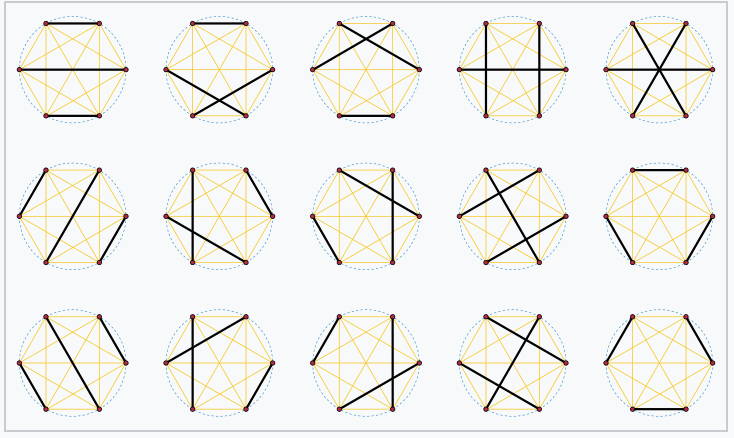If you only wanted to quotient by symmetries of the cube, and not by shift (and presumably, reversal) of paths, there would be a very clean answer.
The symmetry group of the cube is $S_n \ltimes \{ \pm 1 \}^n$, which acts on $\{ \pm 1, \pm 2, \ldots, \pm n \}$ in the obvious way.
We want to consider permutations of the set $\{ \pm 1, \pm 2, \ldots, \pm n \}$, up to the action of the symmetries of the cube.
This action is free, so there are
$$\frac{(2n)!}{2^n n!} = (2n-1) (2n-3) (2n-5) \cdots 5 \cdot 3 \cdot 1 = (2n-1)!!$$
walks up to symmetries of the cube. (Reference for double factorial notation.)
We can biject these "walks up to symmetries of the cube" with ways to partition $\{ 1,2,3,\ldots, 2n \}$ into $n$ sets of size $2$: We have a block $\{ i,j \}$ in the partition if the $i$-th step and the $j$-th step are edges in opposite directions. For example, your walk $(+1,+2,+3,-1,-3,-2)$ corresponds to the partition $\{ 1,4 \} \sqcup \{ 2,6 \} \sqcup \{ 3,5 \}$. I'll visualize this by drawing $2n$ points around the boundary of a circle, connected by chords.
The figure below, taken from Wikipedia, shows the $15 = 5!!$ chord diagrams in the $n=3$ case, corresponding to the walks in a $3$ dimensional cube.

Now, we want to quotient further by shifting the walk sequences, and I assume also by reversing them. This gives an action of the dihedral group of order $4n$. In terms of our chord diagrams, we want to count these chord diagrams up to rotation and reflections.
I have edited the Wikipedia figure to show how the $15$ walks, above, are grouped into the $5$ classes that you found.

We can do this using Burnside's lemma. Recall: Let $G$ be a finite group acting on a finite set $X$. Then Burnside's lemma says that the number of orbits of $G$ on $X$ is
$$\frac{1}{|G|} \sum_{g \in G} |X^g|. $$
So, for each $g$ in the dihedral group, we need to figure out how many chord diagrams are fixed by $g$. (For an easier problem using the same strategy, see how we use Burnside's lemma to count necklaces up to rotation.)
It will be convenient to introduce the notation.
$$\tau_m(x) := \sum_{k=0}^{\lfloor m/2 \rfloor} \binom{m}{2k} (2k-1)!! \cdot x^k. $$
For example,
$$\tau_4(x) = 1+\binom{4}{2} 1!! x + \binom{4}{4} 3!! x^2 = 1 + 6 x + 3 x^2.$$
In other words, the coefficients of $\tau_m$ are the rows of https://oeis.org/A100861 .
We now carry out the Burnside computation, and break into cases:
Case 1: $g$ is a rotation with period $d$ for $d$ odd.
So $g$ breaks $\{1,2,\ldots, 2n \}$ up into $\tfrac{2n}{d}$ orbits, each of size $d$. A $g$-invariant matching must pair these orbits up with each other. There are $\left( \tfrac{2n}{d} -1 \right)!!$ ways to pair off the orbits and then, for each pair of orbits, there are $d$ $g$-invariant ways to match them. (Match one element arbitrarily, the rest are fixed.) So, in this case,
$$|X^g| = \left( \frac{2n}{d} -1 \right)!! d^{n/d}.$$
Case 2: $g$ is a rotation with period $d$ for $d$ even.
Again $g$ breaks $\{1,2,\ldots, 2n \}$ up into $\tfrac{2n}{d}$ orbits, each of size $d$. We can still pair off orbits with each other, but we can also choose one of the orbits and match it within itself. In each orbit $\{ z, gz, g^2 z, \ldots, g^d z \}$, there is a unique $g$-invariant matching, namely, matching $g^i z$ with $g^{i+d/2} z$.
So we must choose $n/2d - 2k$ of the orbits to match with themselves, then pair off the remaining $2k$ orbits in one of $(2k-1)!!$ possible ways and, finally, for each pair of orbits, choose one of the $d$ many possible matchings. In short, in this case,
$$|X^g| = \tau_{2n/d}(d).$$
Case 3: $g$ is a reflection with no fixed points.
This is exactly like Case 2 for $d=2$, we have
$$|X^g| = \tau_{n}(2).$$
Case 4: $g$ is a reflection with two fixed points.
The two fixed points must be matched to each other. The remaining $2n-2$ points act just like Case $3$, so
$$|X^g| = \tau_{n-1}(2).$$
Summing over the whole dihedral group, we get our FINAL ANSWER:
$$\frac{1}{4n} \left( \sum_{d|2n,\ d \ \text{odd}} \phi(d) \left( \frac{2n}{d} -1 \right)!! d^{n/d} + \sum_{d|2n,\ d \ \text{even}} \phi(d) \tau_{2n/d}(d) + n \tau_n(2) + n \tau_{n-1}(2) \right).$$
Here $\phi(d)$ is Euler's totient function, which counts the number of order $d$ rotations in the dihedral group.
For example, when $n=3$, we get
$$\frac{1}{12} \left( \phi(1) \cdot 5!! + \phi(3) \cdot 1!! \cdot 3 + \phi(2) \tau_{3}(2) + \phi(6) \tau_1(6) + 3 \tau_3(2) + 3 \tau_2(2) \right)=$$
$$\frac{1}{12} (1 \cdot 15 + 2 \cdot 3 + 1 \cdot 7 + 2 \cdot 1 + 3 \cdot 7 + 3 \cdot 3)=5.$$
You can enjoy going through the diagram of fifteen matchings above, considering the various elements in the hexagonal dihedral group, and seeing how they fix $15$, $3$, $7$, $1$, $7$ or $3$ matchings.



